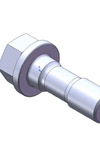Back to Basics, Part 1
 I have little doubt that, for many of you reading it, much of this short article and those that follow will be a case of ‘teaching Granny to suck eggs’. However, for those who are involved in engine design, possibly as beginners, an understanding of how a fastener develops load via the application of torque is a useful lesson. These articles don’t pretend to be a full guide to fastener and joint design (there are some very authoritative books on the subject), but will help give a basic understanding. This month’s article looks at the relationship between force and torque.
I have little doubt that, for many of you reading it, much of this short article and those that follow will be a case of ‘teaching Granny to suck eggs’. However, for those who are involved in engine design, possibly as beginners, an understanding of how a fastener develops load via the application of torque is a useful lesson. These articles don’t pretend to be a full guide to fastener and joint design (there are some very authoritative books on the subject), but will help give a basic understanding. This month’s article looks at the relationship between force and torque.
Developing Force:
If we initially imagine that the thread on the fastener is ‘unwound’, with the axis of the bolt vertical, we would find that the thread is basically a wedge wound around a shank. The action of winding the fastener into the joint is much the same as forcing a wedge into a slit in a piece of wood. It is easy to push the wedge in by hand initially and then, as the wedge contacts both surfaces, resistance is increased and so it is with the fastener. Initially, if the threads are in good condition, the bolt should wind in by hand (there are some special circumstances where this isn’t true, but we will ignore these at the moment) and once the joint becomes tight, resistance increases. Thereafter, for a simple, stiff joint, providing friction remains constant and there is no yielding, tightening torque and fastener load increase linearly. Providing that we know the relationship between torque and force, and we know the load required on the fastener, we can tighten it (either the nut or the bolt) to a given torque to produce this load.
The torque required to produce a given load is given by the relationship below:
T = 0.159P + 0.578µpdp + 0.5 µwdw
where:
T = torque (Nm)
P = thread pitch (m)
µp = coefficient of friction between the thread elements
dp = pitch diameter (m)
µw = coefficient of friction between nut face (or bolt underhead) and the washer face
dw = washer face mean contact diameter
Therefore we can see that the load depends on quite a number of factors. There are much simpler equations, widely used, which lump these factors together as a ‘nut factor’ in the relationship below:
T = kP
where k is the nut factor. I would advise that you avoid this relationship unless you always use exactly the fasteners to which the equation applies, for it ignores the effects of those factors which you are likely to want to change. In Formula One there are few standard fasteners used (maybe more in future!), and most are to a custom design. This is true in a lot of other racing formulae albeit to a lesser extent. Also, in Formula One, the relationship between torque and load is often determined experimentally or by analysis. However, for those without such luxuries, the longer of the two equations should serve you well.
Future articles will examine how to determine a realistic pre-load, the effects of cyclic loading, fastener design, manufacture and materials.
For those of you who would like to refer to a good text on design of bolted joints, I can recommend the books by John Bickford, of which the handbook is the most comprehensive. These books are sought after and you will find that second hand copies change hands for hundreds of pounds in some cases!
1. Introduction to the Design and Behavior of Bolted Joints
2. Handbook of Bolts and Bolted Joints
Written by Wayne Ward.